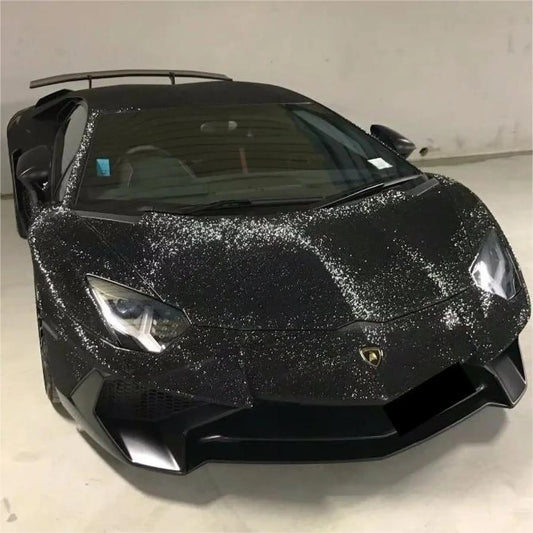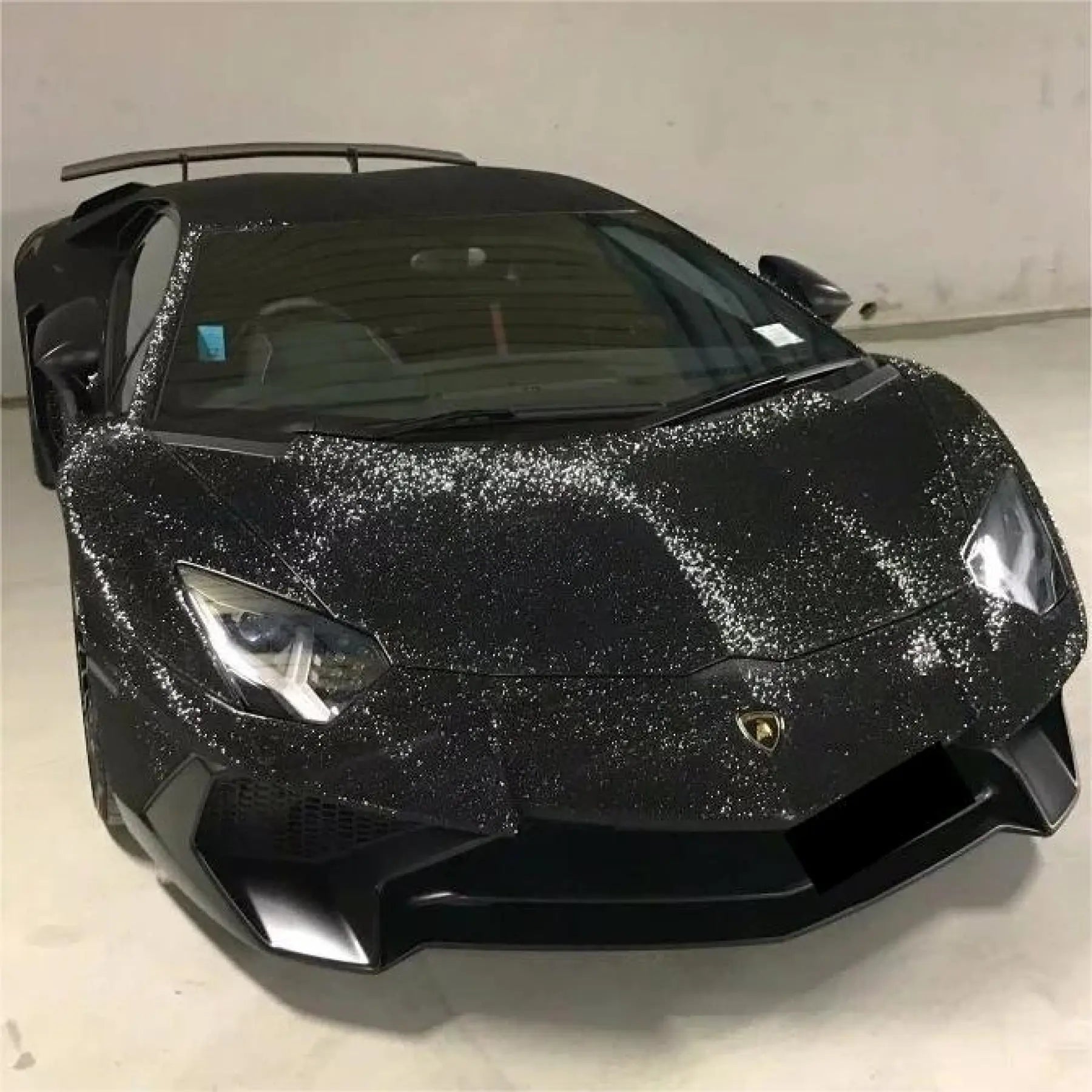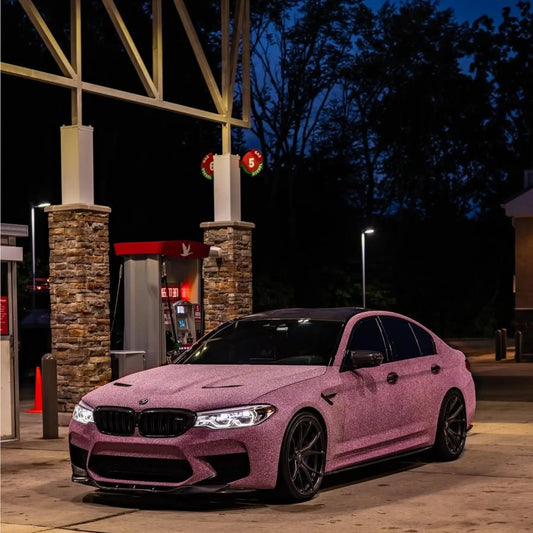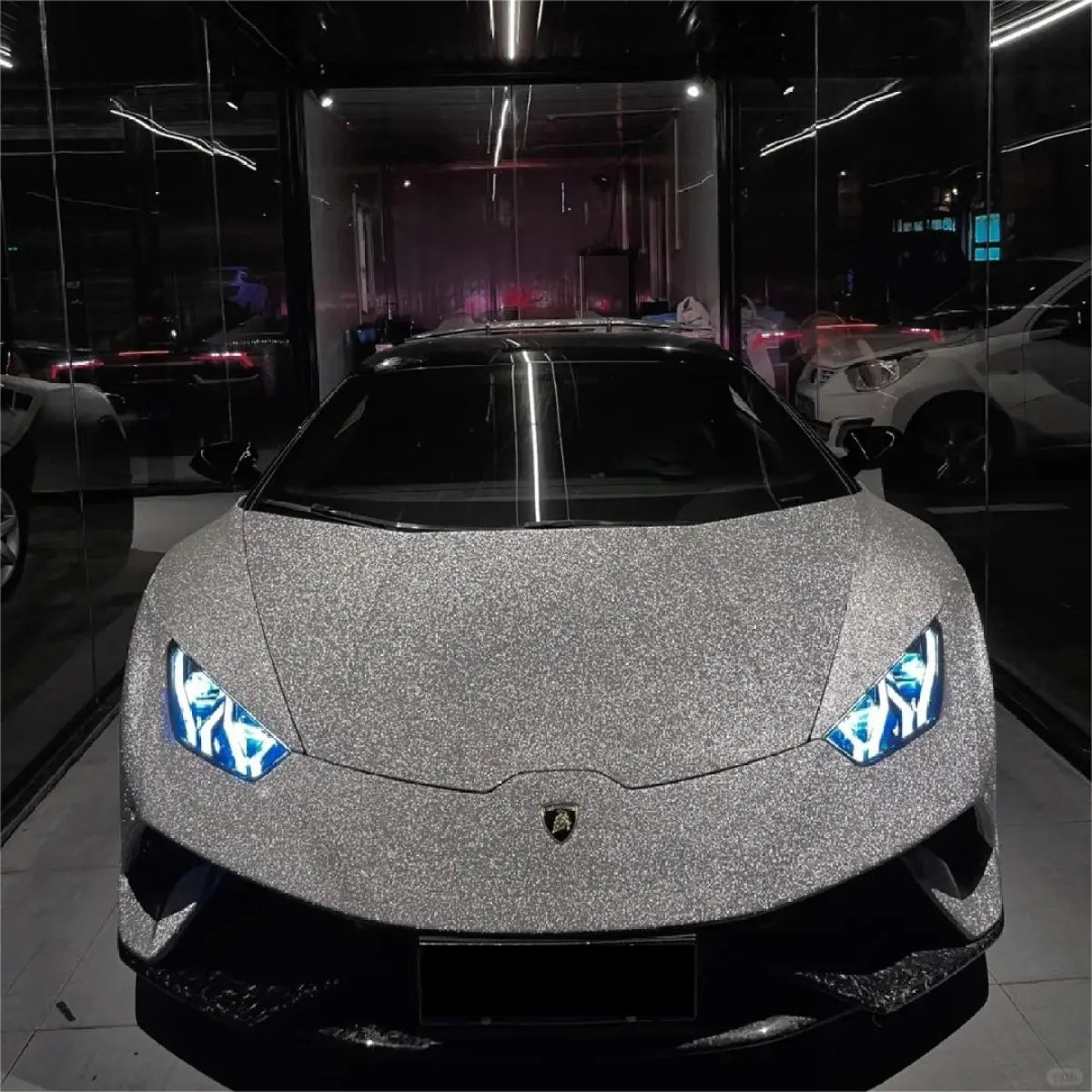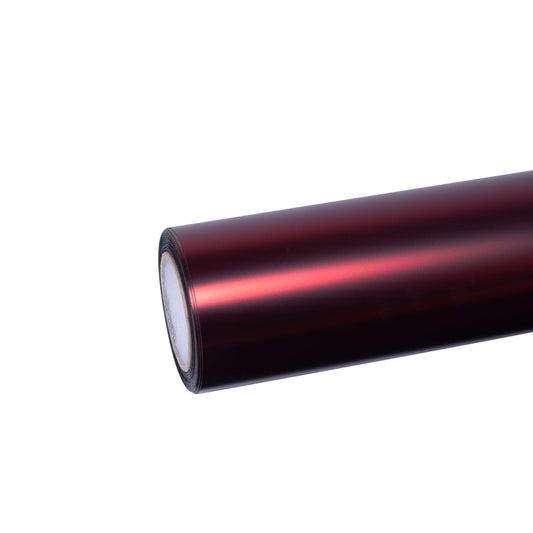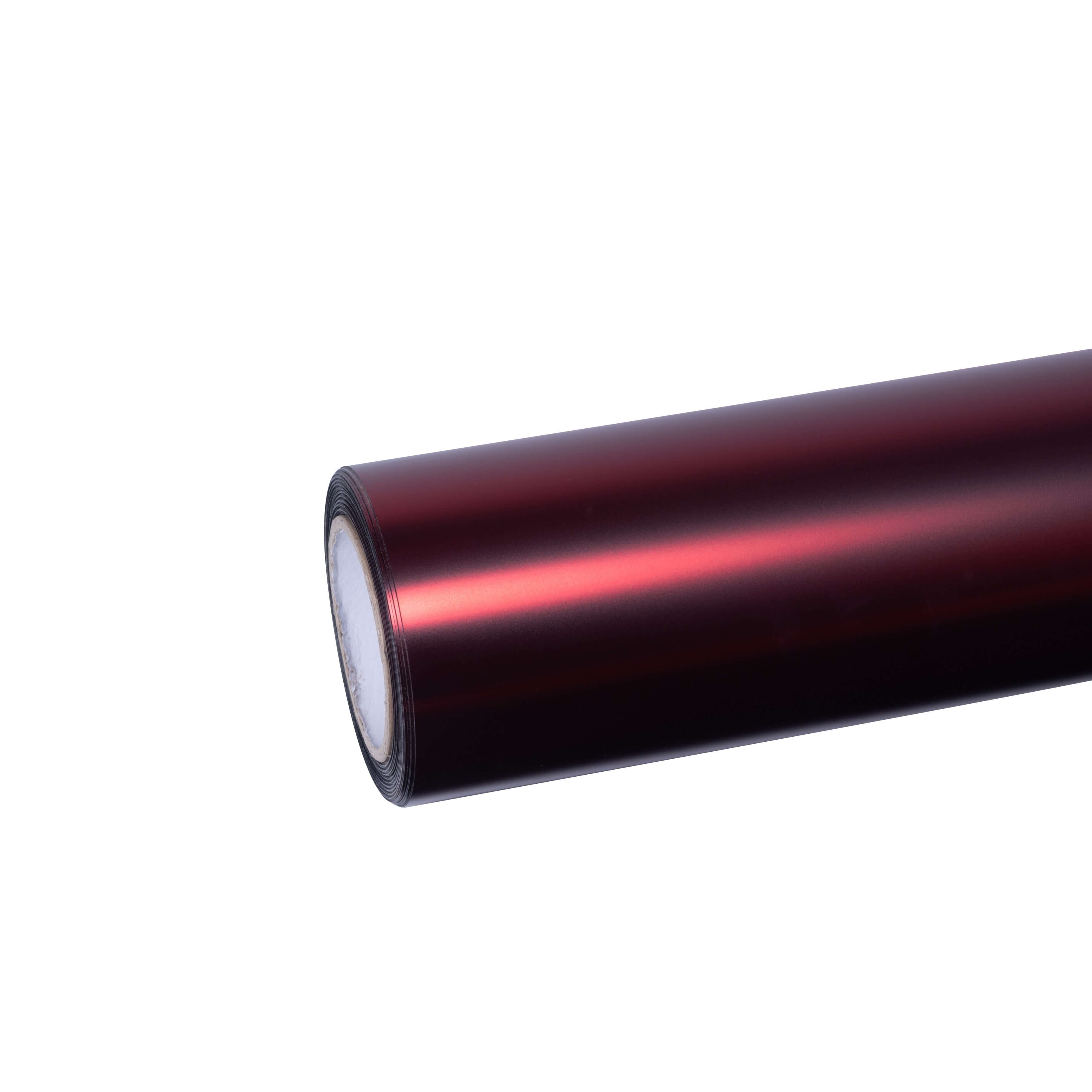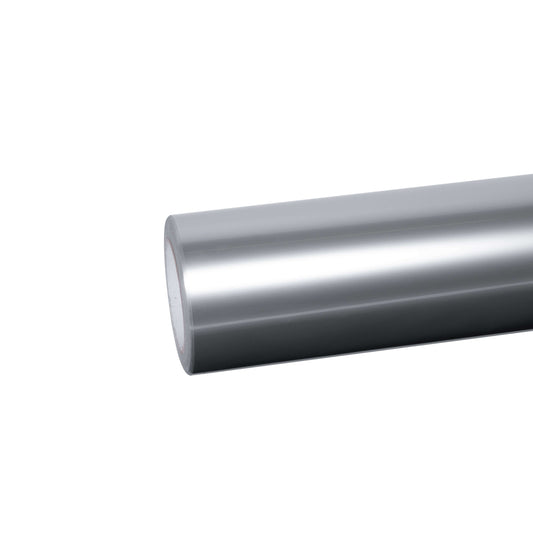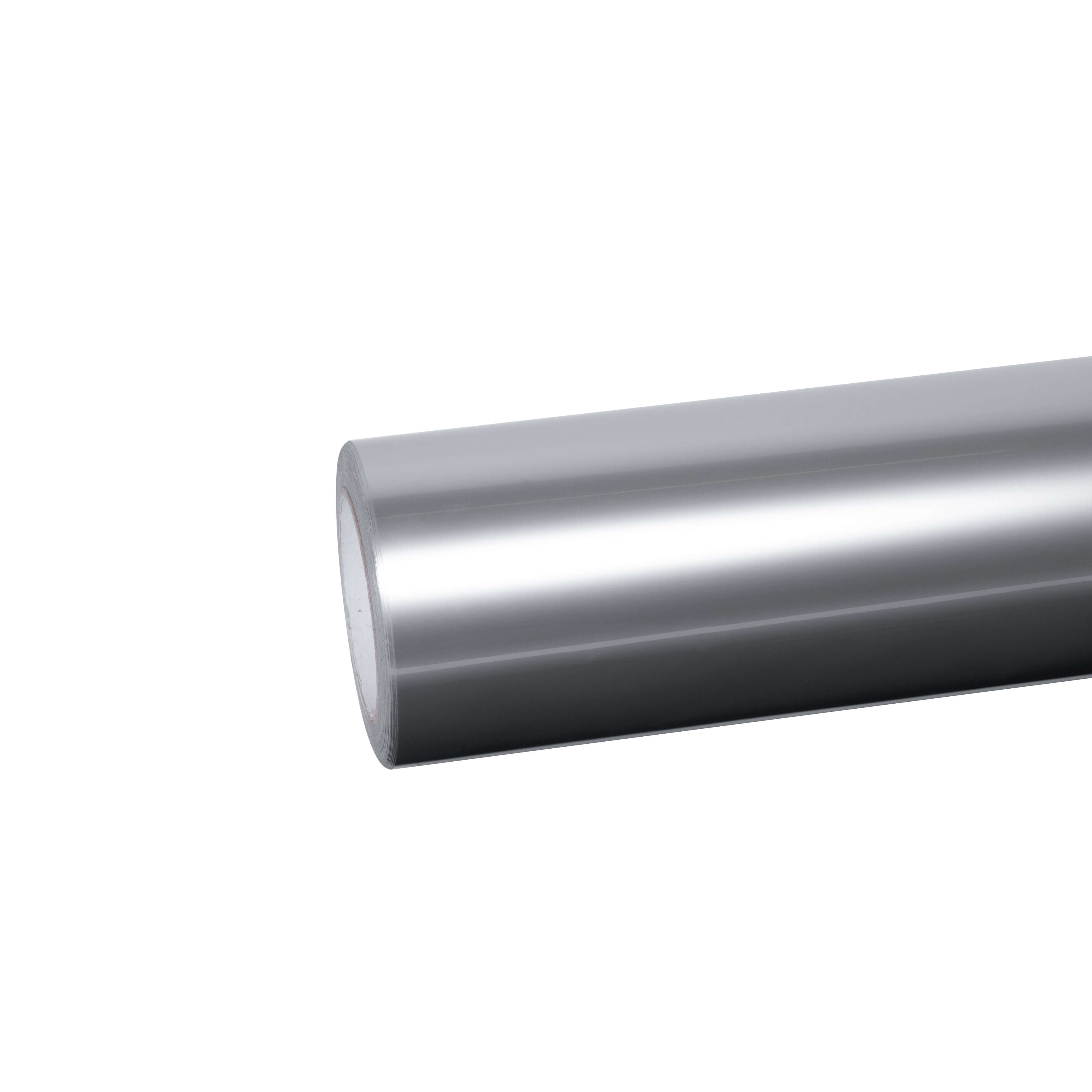Why Seasonal Car Wrap Maintenance Matters
Vehicle wraps face dramatically different environmental stressors depending on the season. According to industry research, wraps that receive proper seasonal care can last 7-10 years, while neglected wraps may deteriorate in just 3-4 years. This significant difference highlights why adapting your maintenance routine to seasonal challenges is crucial for protecting your investment.
The Science Behind Weather Impact on Vinyl Wraps
Vinyl materials respond dynamically to temperature fluctuations, moisture levels, and environmental contaminants. During extreme heat, vinyl becomes more pliable and susceptible to stretching or warping. In freezing conditions, the same material becomes brittle and prone to cracking. Understanding these physical changes allows you to implement preventive measures that extend wrap lifespan dramatically.
The vinyl wrap material used in premium collections like Metallic Vinyl Wrap and Liquid Chrome Wrap contains multiple protective layers, but seasonal maintenance amplifies these built-in defenses.
Winter Car Wrap Care: Protecting Against Cold, Ice, and Salt
Winter presents perhaps the most challenging conditions for vehicle wraps. Freezing temperatures, ice accumulation, corrosive road salt, and constant freeze-thaw cycles all conspire to degrade vinyl materials if proper precautions aren't taken.
The Triple Threat of Winter Weather
Freezing Temperatures and Brittleness When temperatures drop below freezing, vinyl wrap materials contract and become increasingly brittle. This brittleness makes wraps vulnerable to cracking, especially in high-stress areas like door edges, bumpers, and body contours. Collections like Crystal Vinyl Wrap and 3D Carbon Fiber Wrap require extra attention during cold snaps to prevent structural damage.
Road Salt Corrosion Road salt and de-icing chemicals are among the most destructive substances your wrap will encounter. These corrosive materials dehydrate vinyl, causing discoloration, surface deterioration, and premature adhesive failure. Salt buildup is particularly problematic on horizontal surfaces and lower body panels where splash-back accumulates.
Ice Accumulation Damage Snow that melts and refreezes creates ice that adheres stubbornly to vinyl surfaces. Attempting to scrape ice directly from your wrap causes scratches, tears, and lifted edges that compromise both appearance and structural integrity.
Essential Winter Maintenance Protocols
Increased Washing Frequency During winter months, wash your wrapped vehicle at least once weekly—more frequently if you regularly drive on salted roads. This aggressive washing schedule prevents salt and chemical buildup that causes permanent damage.
Winter Washing Best Practices:
- Use lukewarm (never hot) water to avoid thermal shock to cold vinyl
- Employ pH-neutral, wrap-safe car shampoo specifically formulated for vinyl
- Focus extra attention on wheel wells, rocker panels, and lower body sections where salt accumulates
- Rinse thoroughly, ensuring all soap residue is removed
- Dry immediately with clean microfiber towels to prevent ice formation
Safe Snow and Ice Removal Never use ice scrapers, sharp tools, or excessive force on wrapped surfaces. Instead:
- Brush snow off gently with a soft-bristled brush designed for vehicle surfaces
- Use lukewarm water to melt ice rather than scraping
- Allow natural thawing in warmer environments when possible
- Start your vehicle and use defrosters to warm surfaces from beneath
For specialty finishes like Glitter Sparkle Car Wrap or Dual Color Dream Vinyl Wrap, these delicate approaches prevent damage to textured or layered surfaces.
Strategic Parking Solutions Garage parking provides optimal winter protection by:
- Maintaining consistent temperatures that prevent freeze-thaw cycling
- Eliminating snow and ice accumulation
- Protecting against road salt exposure when parked
- Reducing overall weather-related stress on vinyl materials
If garage parking isn't available, invest in a high-quality, breathable car cover specifically designed for wrapped vehicles. Ensure the cover is completely dry before application to prevent moisture entrapment.
Post-Winter Inspection As spring approaches, conduct a thorough inspection of your wrap to identify any winter damage:
- Check edges and seams for lifting or separation
- Examine corners and high-stress areas for cracks
- Look for salt-induced discoloration or fading
- Assess adhesive integrity around door handles and trim pieces
Address any issues immediately to prevent minor problems from escalating into costly repairs.
Summer Car Wrap Protection: Combating Heat and UV Damage
Summer brings intense heat, relentless UV radiation, and environmental pollutants that pose serious threats to vehicle wraps. While winter's challenges are aggressive and immediate, summer damage accumulates gradually through continuous exposure.
Understanding Summer's Destructive Forces
UV Radiation Degradation Ultraviolet rays are the primary cause of color fading and material breakdown in vinyl wraps. UV exposure causes photodegradation, a chemical process that breaks down pigment molecules and weakens polymer structures. Horizontal surfaces like hoods, roofs, and trunk lids receive the most intense UV exposure and fade fastest without proper protection.
Premium Sailifilm products like Colored Paint Protection Film incorporate advanced UV stabilizers, but supplemental protection maximizes longevity.
Heat-Induced Adhesive Weakening Extreme temperatures above 100°F cause vinyl adhesives to soften, potentially leading to:
- Bubbling in flat surface areas
- Edge lifting and peeling
- Stretching and distortion on curved surfaces
- Accelerated color fading in dark hues
Environmental Contaminant Bonding Hot surfaces cause environmental contaminants to bond more aggressively to vinyl:
- Tree sap hardens and becomes difficult to remove
- Bird droppings bake onto surfaces, causing etching
- Industrial fallout and pollution particles embed in the vinyl
- Road tar and asphalt residue adhere permanently
Comprehensive Summer Care Strategies
Strategic Parking and Shade Protection Minimize direct sun exposure whenever possible:
- Park in covered structures, garages, or shaded areas
- Use reflective windshield sunshades to reduce interior heat buildup
- Consider portable carports for regular outdoor parking situations
- Avoid parking under trees (falling sap and bird droppings cause more damage than sun protection provides)
For vehicles wrapped in heat-sensitive finishes like Best Sellers collections, shade parking can extend lifespan by 40-60%.
UV Protection Application Apply vinyl-safe UV protectant sprays or sealants every 3-4 months during summer:
- Choose products specifically formulated for wrapped vehicles
- Apply in shaded areas during cooler parts of the day
- Use even, light coats rather than heavy applications
- Buff gently with microfiber cloths for even distribution
Ceramic Coating Summer Benefits Ceramic coating provides exceptional summer protection by:
- Blocking up to 60% of harmful UV radiation
- Creating hydrophobic surfaces that repel contaminants
- Reducing heat absorption through reflective properties
- Simplifying cleaning by preventing bonding of environmental pollutants
When applied to Car Vinyl Wrap products, ceramic coating extends summer performance significantly.
Increased Cleaning Vigilance Summer requires prompt attention to environmental contaminants:
- Inspect daily for bird droppings, sap, or bug splatter
- Clean contaminants within 24-48 hours to prevent permanent staining
- Wash weekly or bi-weekly depending on environmental exposure
- Use cooler early morning or evening hours for washing to prevent water spotting
Summer Washing Technique:
- Wash in shaded areas to prevent rapid drying and water spots
- Use cool or lukewarm water (never cold water on hot vinyl)
- Work from top to bottom in small sections
- Rinse frequently to prevent soap from drying on surfaces
- Dry immediately with clean microfiber towels
Temperature-Conscious Maintenance Avoid washing or handling wraps during peak heat:
- Don't wash vehicles when surface temperatures exceed 100°F
- Allow wrapped surfaces to cool before applying any products
- Schedule maintenance during cooler morning or evening hours
- Monitor weather forecasts for optimal maintenance windows
Spring Car Wrap Maintenance: Renewal and Recovery
Spring serves as the critical transition season, offering the perfect opportunity to assess winter damage and prepare for summer challenges. This seasonal window allows for repairs, deep cleaning, and protective treatments that maximize year-round performance.
Spring's Unique Challenges
Pollen and Tree Sap Accumulation Spring brings heavy pollen loads and sticky tree sap that adheres to vinyl surfaces. These organic contaminants contain acids that can etch and stain wraps if not removed promptly. Ultra Matte Wrap finishes are particularly susceptible to pollen staining due to their textured surfaces.
Temperature Fluctuations Rapid temperature swings between warm days and cool nights cause vinyl to expand and contract repeatedly. This constant movement can stress adhesive bonds and reveal winter damage that wasn't immediately apparent.
Increased Precipitation Spring rains wash away winter salt but introduce new challenges:
- Water spots from mineral-rich rainwater
- Moisture infiltration into damaged edges or seams
- Increased humidity affecting adhesive performance
Spring Renewal Protocol
Comprehensive Post-Winter Cleaning Conduct an intensive deep cleaning to remove all winter residue:
- Use dedicated bug and tar removers for stubborn winter buildup
- Clean wheel wells and undercarriage areas thoroughly
- Pay special attention to seams and edges where salt accumulates
- Use compressed air to remove debris from intricate wrap details
Damage Assessment and Repair Early spring is ideal for professional inspection and repairs:
- Schedule professional assessment with qualified installers
- Address any lifting, peeling, or bubbling immediately
- Repair small tears before they expand
- Re-seal edges using heat application when appropriate
Protective Coating Application Spring provides optimal conditions for applying protective treatments:
- Moderate temperatures ensure proper ceramic coating curing
- Lower humidity prevents application complications
- Preparing wraps now provides maximum summer protection
Pollen Management Strategy Implement aggressive pollen removal tactics:
- Rinse vehicles daily during peak pollen season
- Use quick detailer sprays between full washes
- Avoid parking under flowering trees
- Consider using car covers during overnight pollen drops
For textured finishes in collections like Rainbow Laser Vinyl Wrap, gentle brushing with soft-bristled detailing brushes helps remove trapped pollen from surface contours.
Fall Car Wrap Care: Preparing for Winter
Fall is the preparatory season—your last opportunity to strengthen wrap defenses before winter's assault. Strategic fall maintenance significantly impacts how well your wrap survives the coming cold months.
Fall Environmental Factors
Falling Leaves and Organic Debris Wet leaves create multiple problems:
- Trapped moisture against vinyl surfaces promotes mildew
- Organic acids from decomposing leaves stain wraps
- Accumulated debris blocks drainage channels and traps water
- Heavy leaf piles scratch surfaces when removed carelessly
Early Frost Formation Morning frost creates ice crystals that expand in vinyl texture, potentially causing micro-tears and surface degradation.
Pre-Winter Precipitation Fall rains prepare roads for winter salt application, introducing early chemical exposure to wrapped vehicles.
Fall Preparation Strategies
Thorough Cleaning and Decontamination Clean vehicles meticulously before winter:
- Remove all organic materials, sap, and bug residue
- Use clay bar treatments on glossy finishes to remove embedded contaminants
- Clean door jambs, trunk seals, and hidden areas where moisture collects
- Ensure complete drying to prevent freezing in seals and crevices
Protective Sealant Application Apply fresh protective coatings before winter:
- Vinyl-safe sealants create barriers against salt and moisture
- UV protectants applied now continue working through winter
- Consider additional ceramic coating if existing protection has degraded
Edge Sealing Verification Check all edges and seams for potential moisture entry points:
- Heat-seal any slightly lifted edges before freezing temperatures arrive
- Apply edge sealant products to vulnerable areas
- Inspect door handles, mirror bases, and trim pieces carefully
Leaf and Debris Prevention Implement strategies to minimize organic accumulation:
- Brush leaves off promptly before they decompose on surfaces
- Avoid parking under deciduous trees during leaf-fall season
- Use car covers when parking outdoors overnight
- Clear drainage channels regularly to prevent water accumulation
Pre-Winter Professional Inspection Schedule fall maintenance appointments with wrap specialists:
- Professional assessment identifies hidden winter vulnerabilities
- Expert repairs prevent small issues from becoming winter disasters
- Technician-applied sealants provide superior protection
- Documentation of wrap condition establishes baseline for spring assessment
Year-Round Universal Maintenance Best Practices
Regardless of season, certain maintenance principles apply universally to all vehicle wraps and ensure maximum longevity across all weather conditions.
Hand Washing Fundamentals
The Gold Standard Method:
- Wash every 1-2 weeks minimum (increase frequency based on environmental exposure)
- Use pH-neutral, wrap-safe automotive shampoo
- Employ soft microfiber wash mitts or sponges (never brushes or abrasive materials)
- Work in straight lines rather than circular motions to prevent swirl marks
- Rinse thoroughly from top to bottom
- Dry immediately with clean, soft microfiber towels
Products to Avoid:
- Petroleum-based cleaners
- Abrasive compounds or polishes
- Traditional car waxes (can create glossy spots on matte finishes)
- Harsh degreasers or solvents
- Household cleaning products
Proper Drying Techniques
Water spots are the enemy of pristine wraps. Proper drying prevents mineral deposits and ensures optimal appearance:
- Use dedicated drying towels separate from washing mitts
- Pat rather than rub to minimize friction
- Pay extra attention to crevices, emblems, and trim pieces
- Consider using silicone squeegees on large flat surfaces
- Finish with compressed air in hard-to-reach areas
Contaminant Response Protocol
Immediate Action Items: Time is critical when contaminants contact your wrap. The faster you respond, the less likely permanent damage occurs:
Bird Droppings: Remove within 48 hours (sooner in hot weather)
- Soak with warm water to soften
- Gently wipe with microfiber cloth
- Follow with mild soap solution
- Rinse and dry thoroughly
Tree Sap: Remove as soon as noticed
- Apply isopropyl alcohol (70% solution) to affected area
- Allow to sit for 60 seconds
- Wipe gently with microfiber cloth
- Wash area with soap and water
- Rinse and dry
Bug Splatter: Remove after each drive in insect-heavy conditions
- Use bug and tar remover safe for vinyl
- Spray on and let dwell for recommended time
- Wipe gently to avoid grinding debris into vinyl
- Rinse thoroughly
Gas Spills: Clean immediately upon contact
- Rinse extensively with water
- Wash with soap to remove residue
- Dry completely
- Monitor area for discoloration
Inspection and Early Detection
Regular inspections catch problems before they become expensive repairs:
Weekly Visual Checks:
- Scan entire vehicle for new damage
- Check edges and seams for lifting
- Look for discoloration or fading
- Identify any bubbling or texture changes
Monthly Detailed Inspection:
- Examine high-wear areas closely (door handles, gas cap, trunk edge)
- Check under mirrors and in crevices for trapped contaminants
- Assess color consistency across all panels
- Test adhesion at accessible edges
Seasonal Professional Assessment:
- Schedule professional inspections at season transitions
- Document wrap condition with photographs
- Address professional recommendations promptly
- Maintain service records for warranty purposes
Parking Strategies for Long-Term Protection
Where and how you park significantly impacts wrap longevity:
Ideal Parking Conditions:
- Climate-controlled garage (optimal)
- Covered parking structures
- Shaded areas away from trees
- Well-ventilated spaces preventing moisture buildup
Parking Situations to Avoid:
- Direct sunlight for extended periods
- Under trees (sap, pollen, bird droppings)
- Areas with industrial fallout or pollution
- Locations exposed to sprinkler systems (mineral deposits)
- Near construction sites (abrasive dust accumulation)
Advanced Protection: Ceramic Coating and PPF Overlays
For maximum wrap protection across all seasons, consider advanced protective solutions that amplify your wrap's built-in defenses.
Ceramic Coating Benefits for Wrapped Vehicles
Ceramic coating creates a transparent, durable barrier that enhances wrap performance in multiple ways:
Multi-Seasonal Advantages:
- UV Protection: Blocks up to 60% of harmful ultraviolet radiation
- Hydrophobic Properties: Water and contaminants bead and roll off surfaces
- Chemical Resistance: Protects against road salt, acid rain, and pollutants
- Thermal Protection: Reduces heat absorption in summer
- Enhanced Durability: Adds scratch and abrasion resistance
- Easier Cleaning: Smooth surface prevents contaminant bonding
Application Best Practices:
- Apply to freshly cleaned and decontaminated wraps
- Use products specifically formulated for vinyl materials
- Consider professional application for optimal results
- Maintain with regular washing and ceramic boost sprays
- Reapply every 2-3 years depending on product specifications
Ceramic coating is particularly beneficial for specialty finishes like Liquid Chrome Wrap and Metallic Vinyl Wrap, where maintaining reflective properties is essential.
PPF Over Vinyl: Ultimate Protection Strategy
For high-impact areas or maximum protection, applying clear Paint Protection Film over vinyl wraps provides unmatched durability:
Strategic PPF Application Areas:
- Front bumpers and lower fascias
- Hood leading edges
- Door edges and handles
- Rocker panels
- Mirror backs
- High-wear trim pieces
This layered approach combines the aesthetic benefits of vinyl wraps with the superior physical protection of TPU-based PPF, ideal for vehicles regularly exposed to harsh conditions.
Sailifilm's Seasonal Performance Advantage
Every Sailifilm product is engineered with seasonal challenges in mind, incorporating advanced technologies that enhance year-round performance:
Multi-Layer UV Protection
Our TPU Paint Protection Wrap collection features:
- UV-stable polymer formulations resistant to photodegradation
- Multiple protective layers that block harmful radiation
- Color-lock technology maintaining vibrancy across seasons
- Self-healing topcoats that eliminate minor scratches
Temperature-Resistant Adhesives
Sailifilm adhesive systems maintain bonding strength across extreme temperature ranges:
- Stable performance from -40°F to 180°F
- Resistance to freeze-thaw cycling
- Heat-activated adhesion that strengthens in summer
- Low-temperature flexibility preventing winter cracking
Enhanced Surface Protection
Premium collections like Colored Paint Protection Film combine color customization with superior protection:
- 8-10 mil thickness for maximum durability
- Chemical resistance against road salt and de-icing compounds
- Stain-resistant topcoats preventing discoloration
- Five-year warranty covering seasonal performance
Professional Installation Network
Proper installation is crucial for seasonal performance. Sailifilm's network of certified installers ensures:
- Climate-controlled installation environments
- Proper edge sealing preventing moisture intrusion
- Correct tension preventing seasonal expansion issues
- Warranty coverage for installation-related concerns
Creating Your Personalized Seasonal Maintenance Calendar
Develop a customized maintenance schedule based on your climate, driving conditions, and wrap type:
Monthly Routine Tasks
- Hand wash with wrap-safe products
- Inspect for damage or contamination
- Remove environmental contaminants promptly
- Apply quick detailer for surface protection
Seasonal Deep Maintenance
Winter (December-February):
- Weekly washing with focus on salt removal
- Immediate snow and ice removal
- Garage or covered parking whenever possible
- Monthly edge and seam inspection
Spring (March-May):
- Post-winter deep cleaning and decontamination
- Professional damage assessment
- Protective coating application
- Daily pollen removal during peak season
Summer (June-August):
- UV protectant application every 6-8 weeks
- Shade parking strategy
- Immediate contaminant removal
- Weekly washing with cool water
Fall (September-November):
- Comprehensive cleaning before winter
- Edge sealing verification
- Protective coating refresh
- Leaf and debris prevention measures
Annual Professional Services
- Complete wrap inspection by certified technician
- Professional decontamination and deep cleaning
- Ceramic coating application or renewal
- Edge re-sealing and minor repairs
- Performance documentation for warranty purposes
Troubleshooting Common Seasonal Issues
Understanding how to address season-specific problems prevents minor issues from becoming major failures:
Winter Problem Solutions
Issue: White Salt Residue Despite Regular Washing
- Solution: Use dedicated salt remover products
- Increase washing frequency to 2-3 times weekly
- Focus on lower panels and wheel wells
- Consider undercarriage rinses at touchless car washes
Issue: Edge Lifting in Cold Weather
- Solution: Apply gentle heat with heat gun (140-160°F)
- Press edges firmly while warm
- Apply vinyl-safe edge sealant
- Schedule professional re-application if extensive
Issue: Bubble Formation After Thawing
- Solution: Small bubbles may self-resolve as temperatures stabilize
- Large bubbles require professional attention
- Prevent by avoiding water entrapment before freezing
- May indicate adhesive failure requiring replacement
Summer Problem Solutions
Issue: Fading on Horizontal Surfaces
- Solution: Apply UV protectant immediately
- Use ceramic coating for enhanced protection
- Implement strict shade parking
- Consider partial wrap replacement if severe
Issue: Adhesive Softening and Peeling
- Solution: Park in cooler environments
- Avoid washing in extreme heat
- Professional edge re-sealing
- May require adhesive system upgrade
Issue: Hard Water Spots
- Solution: Use distilled water for final rinse
- Dry immediately after washing
- Apply quick detailer to affected areas
- Consider water softening products
Environmental Responsibility in Seasonal Maintenance
Sustainable wrap care benefits both your vehicle and the environment:
Eco-Friendly Product Selection
- Choose biodegradable, pH-neutral cleaning solutions
- Select waterless wash products for water conservation
- Use concentrated products reducing packaging waste
- Opt for ceramic coatings with low VOC content
Water Conservation Techniques
- Use two-bucket wash method minimizing water usage
- Employ spray bottles for spot cleaning
- Consider professional eco-wash services
- Collect and reuse rinse water for non-automotive purposes
Proper Disposal Practices
- Never wash vehicles near storm drains
- Use designated car wash facilities with water treatment
- Dispose of cleaning products according to local regulations
- Recycle empty product containers appropriately
Investment Protection: The Financial Case for Seasonal Maintenance
Consistent seasonal maintenance delivers substantial long-term financial benefits:
Cost Comparison Analysis
With Proper Seasonal Maintenance:
- Wrap lifespan: 7-10 years
- Annual maintenance cost: $300-500
- Total 10-year cost: $3,000-5,000 (wrap + maintenance)
- Replacement frequency: Once per decade
Without Seasonal Maintenance:
- Wrap lifespan: 3-4 years
- Minimal maintenance cost: $0-100 annually
- Total 10-year cost: $6,000-9,000 (multiple wrap replacements)
- Replacement frequency: Every 3-4 years
Net Savings: $3,000-4,000 over 10 years through proper maintenance
Additional Value Protection
- Preserved vehicle resale value (original paint remains protected)
- Professional appearance maintained for business vehicles
- Reduced emergency repair costs
- Extended warranty coverage through documented maintenance
Conclusion: Mastering Year-Round Wrap Care
Seasonal car wrap maintenance isn't complicated—it simply requires awareness, adaptation, and consistency. By understanding how different weather conditions affect vinyl materials and implementing appropriate protective measures, you ensure your Sailifilm wrap maintains its stunning appearance year after year.
Remember these key principles:
Winter: Aggressive salt removal, gentle snow handling, garage parking when possible
Summer: UV protection, shade parking, immediate contaminant removal
Spring: Deep cleaning, damage repair, protective coating application
Fall: Comprehensive preparation, edge sealing, debris prevention
Year-Round: Regular washing, prompt contamination response, professional inspections
Whether you've invested in the eye-catching Dual Color Dream Vinyl Wrap, protective Colored Paint Protection Film, or classic 3D Carbon Fiber Wrap, your seasonal care routine determines how long that investment delivers stunning results.
Ready to explore premium wraps engineered for year-round performance? Browse Sailifilm's complete collection:
- Rainbow Laser Vinyl Wrap - Stunning color-shifting effects
- Ultra Matte Wrap - Sophisticated non-reflective finishes
- Liquid Chrome Wrap - Mirror-like reflective surfaces
- Metallic Vinyl Wrap - Classic metallic appearances
- Best Sellers - Most popular customer choices
Test different styles with our Sample Kits, and equip yourself with professional Wrapping Tools for DIY maintenance.
For additional guidance on wrap care and protection:
- Complete vehicle vinyl wrap guide - Wikipedia
- Paint protection film overview - Wikipedia
- Understanding ceramic coating applications
Your wrap's longevity begins with your care commitment. Implement these seasonal strategies today and enjoy years of head-turning style.
Winter-Specific Wrap Protection Techniques
Summer UV Damage Prevention Guide
Climate-Specific Wrap Selection Guide
Emergency Wrap Repair Solutions
Contaminant Removal Techniques


